REUK.CO.UK
The Renewable Energy Website
This is the printer friendly version of the Severn Barrage Tidal Power article from the Renewable Energy Website REUK.co.uk.
Click here to print
Printed at 05:26am 8th November 2025
Severn Barrage Tidal Power
Find out more about the potential for the world's largest tidal power station - The Severn Barrage
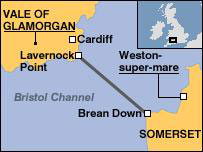
The Severn Barrage is a proposed tidal power (1) station to be built across the Bristol Channel (Severn Estuary). The River Severn has a tidal range of 14 metres - the second highest in the world - making it perfect for tidal power generation.
The 20 billion pound ($US30bn) Severn Barrage would involve the construction of a 10 mile long barrage (dam) between Lavernock Point south of Cardiff, Wales, and Brean Down in Somerset, England. The barrage would act as a bridge between England and Wales and will have an operational lifetime of up to 200 years. It would be the world's largest ever renewable energy project, and the UK's largest engineering project since the Channel Tunnel.
Severn Barrage Electricity Generation
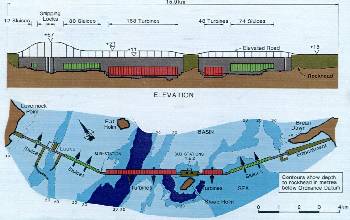
Along the length of the Severn Barrage open sluice gates would allow the tide to flow in. These gates would then be closed at high tide trapping enormous quantities of water behind the barrage.
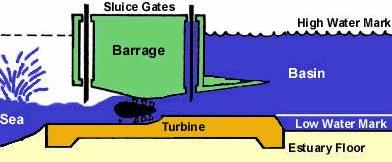
A total of 214 40MW turbines would be built into the barrage through which the trapped water would return at high pressure when the tide turns generating electricity. (In order to permit shipping to pass through the barrage an enormous set of shipping locks would be constructed.)
The tidal turbines along the barrage would generate the same amount of electricity as three of the latest nuclear power stations - 8.6 GW during flow and 2 GW on average. This would be sufficient to provide 5-6% of the current electricity usage of England and Wales - equivalent to 8 large coal-fired power stations.
Producing on average in excess of 17 billion kWh of electricity annually, the UK's carbon emissions (2) would be cut by 16 million tonnes each year (assuming Severn Barrage electricity replaced electricity which would otherwise be generated in coal-fired power stations) which equates to 3% of total current emissions.
Severn Tidal Power Group
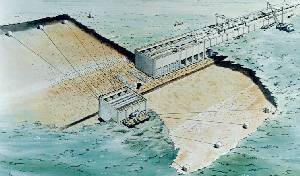
The Severn Tidal Power Group (STGP) is a consortium of engineering and construction companies (Balfour Beatty, Taylor Woodrow, Sir Robert McAlpine and Alstom) formed in 1981 to work on making the Severn Barrage a reality. They suggest that the Severn Barrage could be constructed in just six to eight years for
A total of 200,000 man years of employment would be generated with a total of 35,000 jobs during the peak period of construction. They also suggest that a further 40,000 permanent jobs would be generated in Somerset and South Wales thanks to the benefits of the proximity of the new Severn crossing point.
As of January 2009, five renewable energy schemes remain on the shortlist for the Severn Estuary - one of which is the (government favourite) 8 GWSevern Barrage. The other four shortlisted projects are:
Shoot barrage - 1 GW.
Beachley barrage above the river Wye - 625 MW Bridgwater Bay lagoon - 1.36 GW
Fleming lagoon - 1.36 GW
After a public consultation during 2009, the final decision will be made early in 2010.
Environmental Effects of The Severn Barrage
The environmental effects of a barrage across the River Severn would be enormous. The WWF (3), RSPB (4), and Friends of the Earth (5) have all launched campaigns against the plans to construct the Barrage pointing out that the effects on wildlife in the Severn Estuary would be disastrous and irreversible.
The Severn Estuary is designated a Special Area for Conservation. 85,000 migratory and wintering water birds (waders including oystercatchers, curlews, dunlins, ringed plovers etc) depend on the mud-flats which would be lost as a results of construction of the Barrage. In addition coastal erosion would be increased in some locations while additional silting would occur in others. The Barrage would also increase the likelihood of flooding along the coast on the seawardside.
According to EU-wide wildlife habitat laws, upto 40,000 acres of compensatory habitat (e.g. marshes and/or mudflats) would have to be found at a financial cost of up to £3 billion.
The effect on marine life would not be so extreme since the water in the Severn Estuary contains a lot of silt brought up from the seabed by the effects of the tidal range, however the Barrage could prevent salmon, eels, and other migratory fish from returning to spawn.
Other Negative Effects of the Severn Barrage
With £20 billion spent on such an enormous project, it is very likely that resources would have to be diverted from other renewable technoglogies such a wind power (6) which generate electricity with a much small environmental impact.La Rance Tidal Power
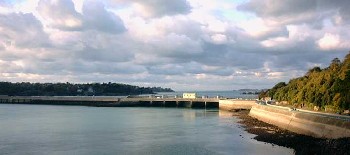
There is still only one large scale commercial tidal power station in the world - La Rance Tidal Power Plant (7) in Brittany, France. This currently generates 240MW of power and has been in operation for over 40 years without mechanical breakdown.
Web Link References
(1) http://www.reuk.co.uk/Introduction-to-Tidal-Power.htm(2) http://www.reuk.co.uk/carbon.htm
(3) http://www.wwf.org.uk/
(4) http://www.rspb.org.uk/
(5) http://www.foe.co.uk/
(6) http://www.reuk.co.uk/wind.htm
(7) http://www.reuk.co.uk/La-Rance-Tidal-Power-Plant.htm
Article from REUK.co.uk:
http://www.reuk.co.uk/Severn-Barrage-Tidal-Power.htm
Published: 24th September 2014
© REUK 2025